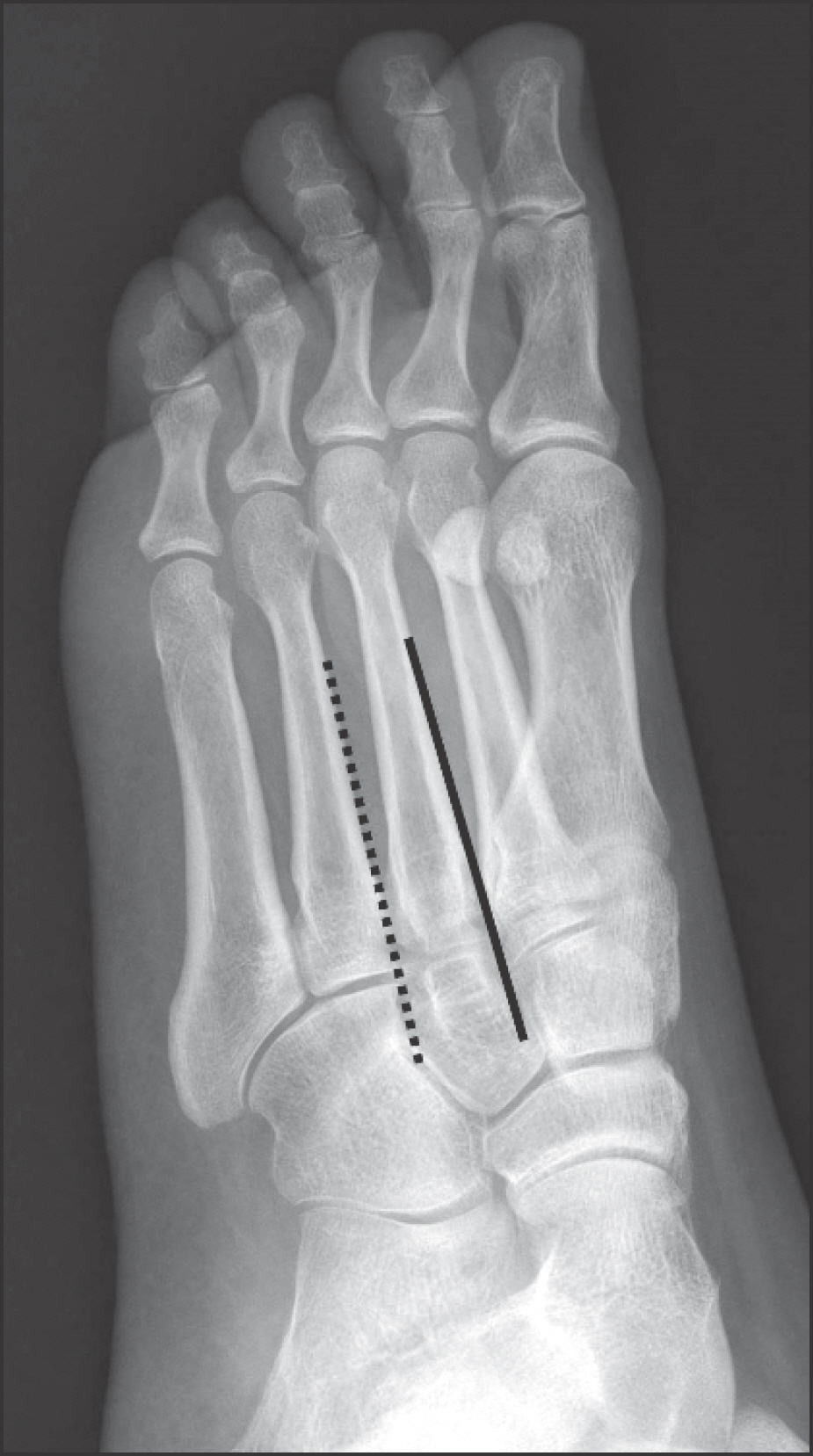J Korean Foot Ankle Soc.
2016 Sep;20(3):106-111. 10.14193/jkfas.2016.20.3.106.
Lisfranc Joint Injury
- Affiliations
-
- 1Department of Orthopaedic Surgery, College of Medicine, Dong-A University, Busan, Korea. tynitus@dau.ac.kr
- KMID: 2351414
- DOI: http://doi.org/10.14193/jkfas.2016.20.3.106
Abstract
- The Lisfranc joint complex is an anatomical association of many bones and articulation, restrained by an even more complex network of ligaments, capsules, and fascia, which must work in concert to provide normal and painless motion. Careful diagnostic workup with high-quality radiographs and computed tomography of the foot are used to diagnose injuries and fractures of this complex. We have to understand the normal anatomy and injury mechanism in order to appropriately treat Lisfranc injuries. Good results have been associated with anatomic reductions of all bones, which was achieved with restoration of proper alignment.
Keyword
Figure
Reference
-
1.Lisfranc J. Nouvelle méthode opératoire pour l’amputation par-tielle du pied dans son articulation tarso-métatarsienne. Paris: Gabon;1815.2.Aitken AP., Poulson D. Dislocations of the tarsometatarsal joint. J Bone Joint Surg Am. 1963. 45:246–60.
Article3.English TA. Dislocations of the metatarsal bone and adjacent toe. J Bone Joint Surg Br. 1964. 46:700–4.
Article4.Hardcastle PH., Reschauer R., Kutscha-Lissberg E., Schoffmann W. Injuries to the tarsometatarsal joint. Incidence, classification and treatment. J Bone Joint Surg Br. 1982. 64:349–56.
Article5.Quénu E., Küss G. Étude sur les luxations du métatarse. Rev Chir Paris. 1929. 39.6.Wilson DW. Injuries of the tarso-metatarsal joints1 Etiology, classification and results of treatment. J Bone Joint Surg Br. 1972. 54:677–86.7.Wilppula E. Tarsometatarsal fracture-dislocation1 Late results in 26 patients. Acta Orthop Scand. 1973. 44:335–45.8.Brunet JA., Wiley JJ. The late results of tarsometatarsal joint inju-ries. J Bone Joint Surg Br. 1987. 69:437–40.
Article9.Ouzounian TJ., Shereff MJ. In vitro determination of midfoot motion. Foot Ankle. 1989. 10:140–6.
Article10.Lenczner EM., Waddell JP., Graham JD. Tarsal-metatarsal (Lisfranc) dislocation. J Trauma. 1974. 14:1012–20.
Article11.Cain PR., Seligson D. Lisfranc’s fracture-dislocation with intercuneiform dislocation: presentation of two cases and a plan for treatment. Foot Ankle. 1981. 2:156–60.
Article12.de Palma L., Santucci A., Sabetta SP., Rapali S. Anatomy of the Lisfranc joint complex. Foot Ankle Int. 1997. 18:356–64.
Article13.Myerson MS., Fisher RT., Burgess AR., Kenzora JE. Fracture dislocations of the tarsometatarsal joints: end results correlated with pathology and treatment. Foot Ankle. 1986. 6:225–42.
Article14.Chiarugi G., Bucciante L. Istitiuaionin di Anatomia dell’uomo1. 10th ed.Milan: Vallardi;1971.15.Yamamoto H., Furuya K., Muneta T., Ishibashi T. Neglected Lisfranc’s joint dislocation. J Orthop Trauma. 1992. 6:129–31.16.Rabin SI. Lisfranc dislocation and associated metatarsophalangeal joint dislocations. A case report and literature review. Am J Orthop (Belle Mead NJ). 1996. 25:325–9.17.Myerson M. The diagnosis and treatment of injuries to the Lisfranc joint complex. Orthop Clin North Am. 1989. 20:655–64.18.O’Malley MJ., Hamilton WG., Munyak J., DeFranco MJ. Stress fractures at the base of the second metatarsal in ballet dancers. Foot Ankle Int. 1996. 17:89–94.
Article19.Berg JH., Silveri CP., Harris M. Variant of the Lisfranc fracture-dislocation: a case report and review of the literature. J Orthop Trauma. 1998. 12:366–9.
Article20.Norfray JF., Geline RA., Steinberg RI., Galinski AW., Gilula LA. Subtleties of Lisfranc fracture-dislocations. AJR Am J Roentgenol. 1981. 137:1151–6.
Article21.Arntz CT., Veith RG., Hansen ST Jr. Fractures and fracture-dislocations of the tarsometatarsal joint. J Bone Joint Surg Am. 1988. 70:.: 173-81.
Article22.Faciszewski T., Burks RT., Manaster BJ. Subtle injuries of the Lisfranc joint. J Bone Joint Surg Am. 1990. 72:1519–22.
Article23.Goossens M., De Stoop N. Lisfranc’s fracture-dislocations: etiology, radiology, and results of treatment. A review of 20 cases. Clin Orthop Relat Res. 1983. 176:154–62.24.Anderson LD. Injuries of the forefoot. Clin Orthop Relat Res. 1977. 122:18–27.
Article25.Granberry WM., Lipscomb PR. Dislocation of the tarsometatarsal joints. Surg Gynecol Obstet. 1962. 114:467–9.26.Markowitz HD., Chase M., Whitelaw GP. Isolated injury of the second tarsometatarsal joint. A case report. Clin Orthop Relat Res. 1989. 248:210–2.27.Stark WA. Occult fracture-subluxation of the midtarsal joint. Clin Orthop Relat Res. 1973. 93:291–2.
Article28.Turco VJ., Spinella AJ. Tarsometatarsal dislocation-Lisfranc injury. Foot Ankle. 1982. 2:362.29.Vuori JP., Aro HT. Lisfranc joint injuries: trauma mechanisms and associated injuries. J Trauma. 1993. 35:40–5.
Article30.Cassebaum WH. Lisfranc fracture-dislocations. Clin Orthop Relat Res. 1963. 30:116–29.31.Ross G., Cronin R., Hauzenblas J., Juliano P. Plantar ecchymosis sign: a clinical aid to diagnosis of occult Lisfranc tarsometatarsal injuries. J Orthop Trauma. 1996. 10:119–22.
Article32.Heckman JD. Fractures and dislocations of the foot1. Rockwood CA, Green DP, Bucholz RW, Heckman JD, editors. editors.Rockwood and Green’s: fractures in adults. 4th ed.Philadelphia: Lippincott-Raven;1996. p.2287.33.Arntz CT., Hansen ST Jr. Dislocations and fracture dislocations of the tarsometatarsal joints. Orthop Clin North Am. 1987. 18:105–14.
Article34.Jeffreys TE. Lisfranc’s fracture-dislocation: a clinical and experimental study of tarso-metatarsal dislocations and fracture-dislocations. J Bone Joint Surg Br. 1963. 45:546–51.35.Pérez Blanco R., Rodríguez Merchán C., Canosa Sevillano R., Munuera Martínez L. Tarsometatarsal fractures and dislocations. J Orthop Trauma. 1988. 2:188–94.36.Resch S., Stenström A. The treatment of tarsometatarsal injuries. Foot Ankle. 1990. 11:117–23.
Article37.Lu J., Ebraheim NA., Skie M., Porshinsky B., Yeasting RA. Radiographic and computed tomographic evaluation of Lisfranc dislocation: a cadaver study. Foot Ankle Int. 1997. 18:351–5.
Article38.Ebraheim NA., Yang H., Lu J., Biyani A. Computer evaluation of second tarsometatarsal joint dislocation. Foot Ankle Int. 1996. 17:685–9.
Article39.Hansen STJ. Fractures of the foot1 In: Browner BD, Jupiter JB, Levine AM, Trafton PG, editors1 Skeletal trauma. 2nd ed.Philadelphia: W.B. Saunders;1998. p.2405.40.Mittlmeier T., Krowiorsch R., Brosinger S., Hudde M. Gait function after fracture-dislocation of the midtarsal and/or tarsometatarsal joints. Clin Biomech (Bristol, Avon). 1997. 12:S16–7.
Article




